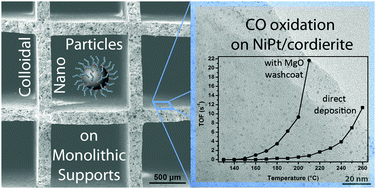Sara Coles is a guest web-writer for Catalysis Science & Technology. She
currently works for Johnson Matthey in Royston, UK.
Foam, fleece and honeycomb have one unexpected thing in common: they are all physical structures that can be made into supports for industrial platinum catalysts.
Patrick Sonström and colleagues in Germany have studied the deposition of colloidally preformed nanoparticles of platinum deposited with or without a washcoat onto low surface area codierite honeycombs, alumina foam and nickel fleece.
Their technique allows higher platinum loadings to be applied without the disadvantages of agglomeration and adhesion, meaning that higher catalytic activities can be achieved on low surface area substrates.
This could have potential to expand the use of monolithically supported platinum catalysts beyond their automotive niche and into wider industrial use for reactions such as methanol steam reforming, oxidative dehydrogenation of propane and liquid phase hydrogenations. The advantages of monolithic catalysts over their classic pellet bed alternatives include lower pressure drops and improved mass transfer.
To find out more about this work read the article in Catalysis Science & Technology:
Foam, fleece and honeycomb: catalytically active coatings from colloidally prepared nanoparticles
Patrick Sonström, Birte Halbach, Sonia Tambou Djakpou, Beate Ritz, Kirsten Ahrenstorf, Georg Grathwohl, Horst Weller and Marcus Bäumer
Catal. Sci. Technol., 2011, 1, 830–838, DOI: 10.1039/c1cy00077b












